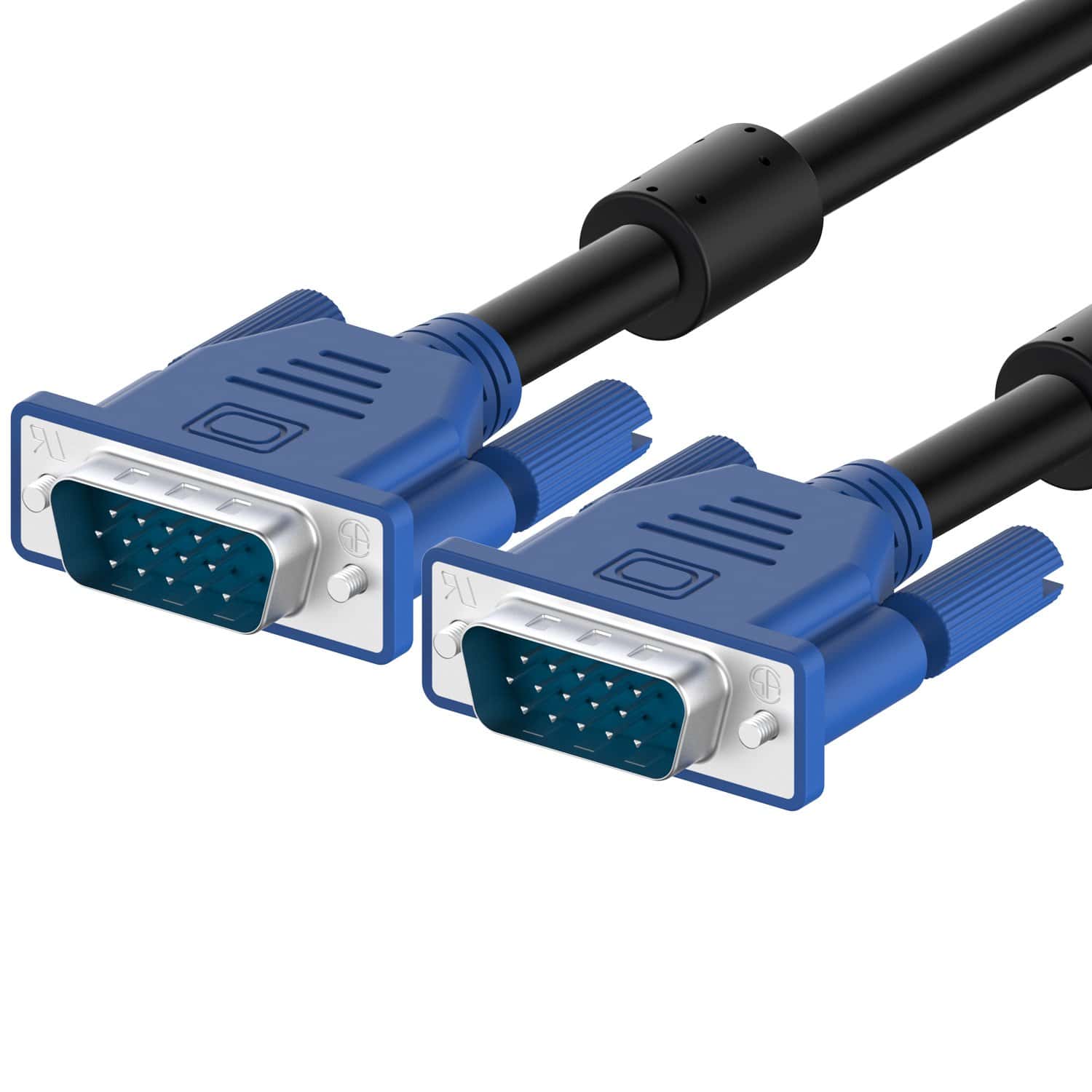VGA cables can’t daisy chain monitors. Daisy chaining monitors requires DisplayPort 1.2 or higher, or Thunderbolt connections that support Multi-Stream Transport (MST).
While VGA can’t handle this task, you have other options. DisplayPort and Thunderbolt let you link multiple screens from a single port on your computer. This setup saves space and cuts cable clutter.
To daisy chain, you’ll need the right gear and steps. We’ll cover what you need and how to set it up. Let’s look at the basics:
| Connection Type | Can Daisy Chain? | Max Monitors |
|---|---|---|
| VGA | No | 1 |
| DisplayPort 1.2+ | Yes | Up to 4 |
| Thunderbolt | Yes | Up to 6 |
Daisy-Chaining Monitors with VGA: Not Possible
Understanding Daisy-Chaining
Daisy-chaining lets you connect many monitors to one computer. You connect the first monitor to the computer. Then, you connect the second monitor to the first, and so on. This creates a “chain” of monitors.
Why VGA Doesn’t Support Daisy-Chaining
VGA is an older technology. It can only send video signals. It can’t send data in the way needed for daisy-chaining. This is different from DisplayPort, which is newer and can handle this.
What to Do Instead
If your computer has enough ports, you can connect each monitor separately. If you don’t have enough ports, you can use a device called a splitter. This lets you connect many monitors to one port. But this may lower the resolution of your displays.
Modern Alternatives to VGA
- DisplayPort: This is the best choice for daisy-chaining. It can handle high resolutions and refresh rates.
- HDMI: This is also a good choice, but it doesn’t support daisy-chaining in the same way as DisplayPort. Some setups may allow for a limited form of daisy-chaining with HDMI, but it’s not as straightforward.
- USB-C: This is a newer type of connector. It can be used for video, data, and power. Some monitors can be daisy-chained with USB-C.
If you’re buying a new monitor, look for one with DisplayPort. This will give you the most flexibility.
Using a VGA Switch
If you have multiple devices with VGA output and want to use them with one monitor, you can use a VGA switch. This allows you to easily switch between different video sources without having to constantly plug and unplug cables. This can be helpful if you have a desktop computer, a laptop, and a gaming console, all with VGA output, and you want to use them with the same monitor.
While daisy-chaining monitors with VGA is not possible due to the limitations of the technology, there are alternative solutions available, such as using a splitter or a switch, depending on your needs. For those seeking to connect multiple monitors, it’s recommended to utilize modern display connectors like DisplayPort or USB-C, which offer greater flexibility and support for daisy-chaining, ensuring a seamless multi-monitor setup.
Understanding Daisy Chaining Technology
Daisy chaining allows multiple monitors to connect in a series. This setup uses specific ports and cables to link displays efficiently.
The Concept of Daisy Chaining
Daisy chaining links devices in a sequence. For monitors, it means connecting one display to another instead of directly to the computer. This method reduces cable clutter and simplifies setups.
The first monitor plugs into the computer. Each subsequent monitor connects to the previous one. This chain passes video signals from one screen to the next.
Daisy chaining requires compatible hardware. Monitors need the right input and output ports. Most setups use DisplayPort or Thunderbolt technology.
Daisy Chain Compatibility
Not all monitors support daisy chaining. You need displays with specific features:
- DisplayPort 1.2 or higher
- Multi-Stream Transport (MST) capability
- Thunderbolt 3 or USB-C with video support
Your computer’s graphics card must also support MST. Check your GPU specifications to ensure compatibility.
| Technology | Max Monitors | Max Resolution |
|---|---|---|
| DisplayPort 1.2 | 4 | 1080p |
| DisplayPort 1.4 | 4 | 4K |
| Thunderbolt 3 | 6 | 4K |
Choose cables carefully. Use high-quality DisplayPort or Thunderbolt cables rated for the bandwidth you need. This ensures proper signal transmission through the chain.
Setting Up Your Daisy Chain with VGA
VGA cables cannot be used for daisy chaining monitors. This setup requires DisplayPort 1.2 or Thunderbolt connections that support Multi-Stream Transport (MST) technology.
Initial Setup Requirements
To daisy chain monitors, you need:
- A computer with DisplayPort 1.2 or Thunderbolt 3 output
- Monitors with DisplayPort 1.2 or Thunderbolt 3 input and output ports
- Compatible cables for each monitor
Check your computer and monitor specifications. Ensure they support MST technology. This is crucial for daisy chaining to work properly.
Purchase high-quality DisplayPort or Thunderbolt cables. Cable quality can affect signal strength and display performance.
DisplayPort 1.2 or greater is required for daisy chaining. VGA lacks this capability due to its analog nature.
Configuring Display Settings
After connecting your monitors with the proper cables, configure your display settings:
- Power on your computer and all monitors
- Right-click on your desktop and select “Display settings”
- Windows should automatically detect your monitors
If not detected, click “Detect” in the display settings menu.
Arrange your monitors by dragging their icons in the settings window. This determines how your cursor moves between screens.
Adjust individual monitor settings:
- Resolution
- Refresh rate
- Scaling
| Setting | Recommendation |
|---|---|
| Resolution | Use each monitor’s native resolution |
| Refresh Rate | Set all monitors to the same rate |
| Scaling | Adjust if text appears too small |
Enable MST in your monitor’s on-screen display menu if required. Some older models may need this step.
Optimizing Your Multitasking Experience
Daisy chaining monitors can greatly enhance your ability to multitask and manage multiple applications. The right setup boosts productivity and keeps your workspace tidy.
Enhancing Productivity
A dual monitor setup allows you to spread out your work across multiple screens. This extra space makes it easier to compare documents side-by-side or keep reference materials open while working on a main task.
To maximize efficiency, assign specific functions to each monitor. For example, use one screen for communication tools like email and chat, and another for your primary work applications.
Consider adjusting display settings for optimal viewing. Match refresh rates and resolutions across monitors to ensure smooth visuals. This helps reduce eye strain during long work sessions.
Some monitors include built-in USB hubs. These provide easy access to peripheral devices, further streamlining your workflow.
Managing Cable Clutter
Daisy chaining helps reduce cable clutter by minimizing the number of cables running to your computer. This creates a cleaner, more organized workspace.
Use cable management solutions to keep remaining wires tidy. Options include:
- Cable clips or ties
- Under-desk cable trays
- Cord covers
| Cable Management Method | Pros | Cons |
|---|---|---|
| Cable clips/ties | Inexpensive, easy to use | May not hide cables completely |
| Under-desk trays | Hides cables from view | Requires installation |
| Cord covers | Protects cables, blends with decor | More expensive, less flexible |
Group similar cables together when possible. This makes troubleshooting easier if issues arise. Label cables at both ends for quick identification.
Regularly assess your setup and remove any unused cables or peripherals. This prevents unnecessary clutter from accumulating over time.
Troubleshooting Common VGA Daisy Chaining Issues
VGA daisy chaining can sometimes encounter problems. Here are solutions for connectivity and performance issues to help you get your multi-monitor setup working smoothly.
Resolving Connectivity Problems
Check all cable connections first. Ensure VGA cables are securely plugged in at both ends. Try unplugging and reconnecting each cable. Verify your graphics card supports multiple VGA outputs.
Update your graphics drivers to the latest version. Outdated drivers can cause detection issues. Right-click on the desktop and select display settings. Make sure Windows recognizes all monitors.
If a monitor isn’t detected, try connecting it directly to the computer. This isolates whether the issue is with the monitor or the daisy chain setup. Test cables individually to identify any faulty ones.
Consider using a VGA splitter if direct daisy chaining doesn’t work. This device allows multiple monitors to connect from a single VGA port.
Addressing Quality and Performance
VGA signal degradation can occur in daisy chains, especially with longer cable runs. Use high-quality, shielded VGA cables to minimize interference. Keep total cable length under 50 feet for best results.
Adjust refresh rates and resolutions. Lower settings if you notice flickering or poor image quality. Start with 60Hz refresh rate and 1024×768 resolution, then increase gradually.
| Resolution | Max Refresh Rate | Image Quality |
|---|---|---|
| 1024×768 | 85 Hz | Good |
| 1280×1024 | 75 Hz | Better |
| 1600×1200 | 60 Hz | Best |
Check for electrical interference. Keep VGA cables away from power cords and other electronics. Use a powered VGA booster for long cable runs to maintain signal strength.
Try different monitor arrangements. Some configurations may work better than others. Experiment with which monitor is first in the chain for optimal performance.
Frequently Asked Questions
VGA connections have limitations for daisy chaining monitors. Here are answers to common questions about using VGA and alternative options for multi-monitor setups.
What is required to daisy chain monitors using VGA connectors?
VGA cables cannot be used to daisy-chain monitors due to their analog technology. VGA lacks the capability to carry multiple video signals through a single cable.
Are there limitations to using VGA for daisy chaining multiple monitors?
Yes. VGA is an analog signal that doesn’t support daisy chaining. It can only transmit one video signal per cable, making it unsuitable for connecting multiple monitors in a chain.
How can I set up dual monitors if my laptop has one HDMI port and I want to use VGA?
You can use an HDMI splitter or a USB to VGA adapter. Connect one monitor via HDMI and the other through the adapter or splitter to achieve a dual-monitor setup.
Is it possible to mix HDMI and VGA connections when daisy chaining monitors?
No. Daisy chaining requires compatible digital connections like DisplayPort or Thunderbolt. You can’t mix HDMI and VGA for daisy chaining.
Can you daisy chain LG monitors using VGA cables?
LG monitors cannot be daisy chained using VGA cables. VGA technology doesn’t support the multi-stream transport needed for daisy chaining.
What are the alternatives to daisy chaining with VGA when the monitors lack DisplayPort?
Use a multi-monitor adapter or docking station. These devices allow you to connect several monitors to a single computer port, bypassing the need for daisy chaining.
| Connection Type | Daisy Chain Support | Max Resolution | Max Refresh Rate |
|---|---|---|---|
| VGA | No | 2048×1536 | 85 Hz |
| DisplayPort | Yes | 8K | 60 Hz |
| HDMI | No | 10K | 120 Hz |
| Thunderbolt | Yes | 8K | 60 Hz |







